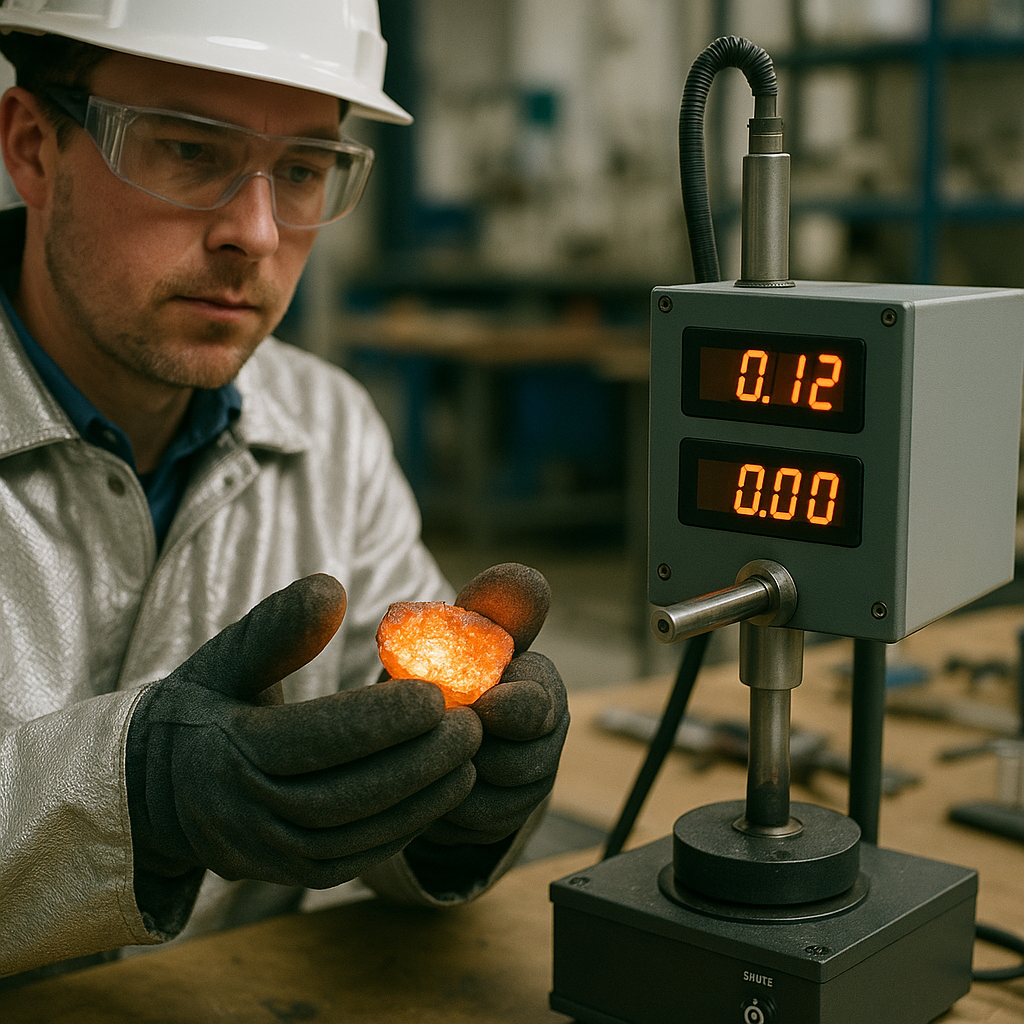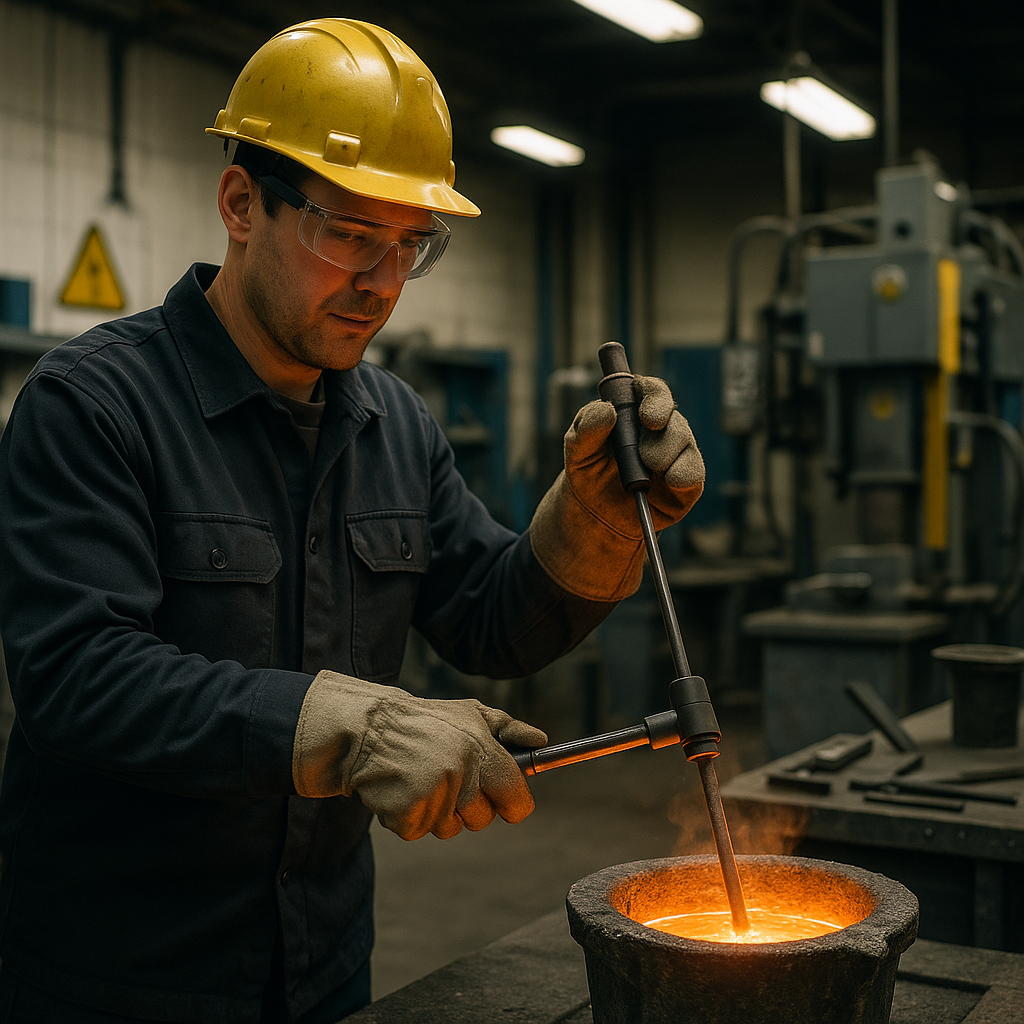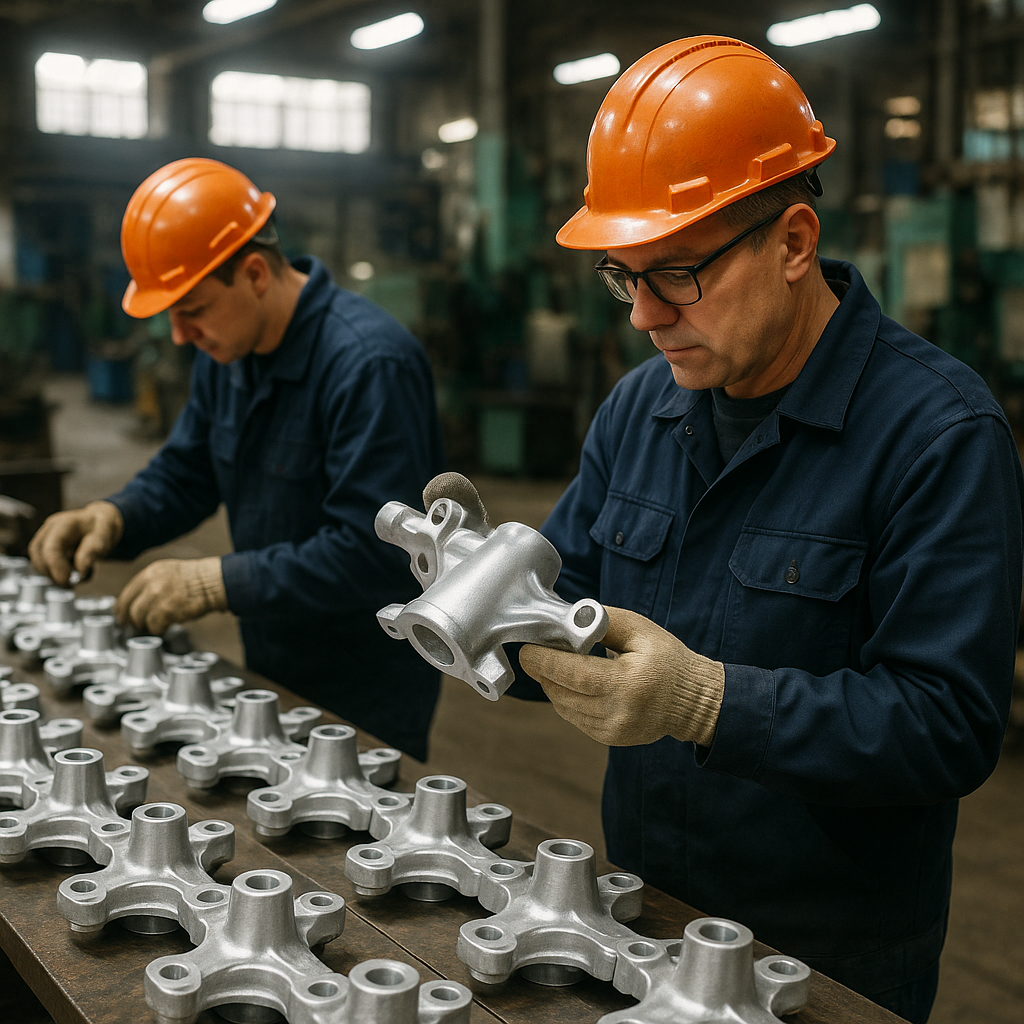5901 Botham Jean Blvd, Dallas, TX 75215
What is Degassing and Why is it Important for Liquid Metals?
October 28, 2025Degassing is the crucial process of removing dissolved gases, primarily hydrogen, from liquid metals during manufacturing. When molten aluminum and other metals come into contact with moist air or wet tools, hydrogen gas gets dissolved in the metal, creating a potential risk for quality issues.
The consequences of neglecting this vital step are significant. During solidification, dissolved hydrogen that remains forms tiny pores throughout the metal structure. While these microscopic voids might initially seem insignificant, they dramatically weaken the mechanical properties of the final product.
For manufacturers in industries such as aerospace and automotive, degassing is essential. Excess hydrogen can lead to rejected parts, compromised structural integrity, and increased scrap rates. With rising material costs and stricter quality specifications, proper degassing has become a cornerstone of sustainable metal casting operations.
What are the Main Methods for Degassing Liquid Metal?
Degassing is a crucial process in metal production, aimed at removing dissolved gases, especially hydrogen, which can cause porosity and defects in the final product. Three primary degassing methods are utilized in the industry, each offering unique advantages and principles.
Purge Gas Injection
Purge gas injection involves introducing inert gases into molten metal to capture and remove dissolved hydrogen. This method creates a concentration gradient that facilitates the diffusion of hydrogen into gas bubbles.
Typically, argon or nitrogen gas is used, introduced through lances, porous plugs, or rotary impellers. As these gas bubbles ascend through the liquid metal, they gather hydrogen and transport it to the surface for removal.
In rotary degassing, a rotating impeller produces smaller, more numerous bubbles, significantly increasing the gas-metal contact surface area and enhancing efficiency. This method is favored for its simplicity and effectiveness in foundries.
Vacuum Degassing
Vacuum degassing involves placing liquid metal in a sealed chamber with significantly reduced pressure. This low-pressure environment decreases hydrogen solubility, prompting it to form bubbles that rise to the surface.
Variations of vacuum degassing include ladle degassing, where an entire ladle of metal is placed in a vacuum chamber, and stream degassing, where metal is poured through a vacuum environment. The vacuum level typically ranges from 0.5 to 10 mbar.
This method is particularly effective at achieving very low hydrogen levels and is often used for high-quality specialty metals requiring exceptional cleanliness. However, it requires more complex equipment and higher operational costs compared to purge gas methods.
Ultrasonic Degassing
Ultrasonic degassing employs high-frequency sound waves to create cavitation bubbles within the molten metal. These microscopic bubbles collect dissolved hydrogen before surfacing.
The ultrasonic vibrations generate alternating high and low-pressure zones in the liquid metal. During low-pressure cycles, tiny cavitation bubbles form, accumulate hydrogen, and release it at the surface during expansion.
This technology can operate continuously, making it suitable for integration into industrial processes. It’s gaining popularity due to its efficiency and ability to remove gases and other impurities without introducing new contaminants.
Key Differences Between Degassing Methods
- Equipment complexity: Purge gas injection is the simplest, vacuum degassing requires specialized chambers and pumping systems, and ultrasonic degassing needs precise frequency generators and transducers.
- Processing time: Ultrasonic degassing is often faster than traditional methods, while vacuum degassing may necessitate longer processing times, especially for large volumes.
- Efficiency: Vacuum degassing typically achieves the lowest hydrogen levels, while rotary purge gas systems offer good efficiency with moderate investment.
- Applications: Purge gas methods are prevalent in aluminum foundries, vacuum degassing is common in steel production, and ultrasonic technology is gaining acceptance in specialty applications requiring high purity.
The choice between these methods depends on factors such as desired metal quality, production volume, alloy type, and economic considerations. Many modern facilities combine multiple techniques for optimal results.
| Method | Working Principle | Pros | Cons | Applications |
|---|---|---|---|---|
| Purge Gas Injection | Inert gases are introduced through molten metal, forming bubbles that collect and remove hydrogen. | Simple, widely used, effective in aluminum foundries. | Less effective in humid environments. | Common in aluminum production. |
| Vacuum Degassing | Pressure is reduced to decrease hydrogen solubility, forming bubbles that rise to the surface. | Achieves very low hydrogen levels, suitable for high-quality metals. | Requires complex equipment and incurs high costs. | Effective for steel and high-purity applications. |
| Ultrasonic Degassing | High-frequency sound waves create cavitation bubbles to collect and remove hydrogen. | Efficient, removes gases and impurities without new contaminants. | Emerging technology with challenges in process control. | Specialty applications requiring high purity. |
How is Degassing Effectiveness Measured?

Measuring degassing effectiveness is crucial for ensuring metal quality and performance. The industry primarily uses two methodologies: sampling techniques and in-situ methods. Each offers valuable insights into hydrogen content and other dissolved gases that could compromise product integrity.
The Reduced Pressure Test (RPT) is widely used in aluminum casting operations. This test involves taking a molten metal sample and placing it in a vacuum chamber where pressure is reduced. As the sample solidifies, dissolved hydrogen forms visible porosity. The density of the solidified sample is measured to quantify gas content, with lower density indicating higher hydrogen levels. For critical applications requiring minimal gas content, technicians may count surface bubbles during solidification.
For medium to high gas contents, RPT employs higher test pressures (lower vacuums), so gas remains inside the sample during solidification. The specific gravity of this sample directly correlates with degassing efficiency. Technicians examine cross-sections to assess porosity distribution and size.
In-Situ Measurement Methods
In-situ techniques offer real-time monitoring, avoiding potential sampling errors. These methods typically use a system that circulates inert gas through the melt via a sample probe. The inert gas collects hydrogen as it moves through the molten metal and is then analyzed using differential thermal conductivity sensors. This process continues until hydrogen content reaches equilibrium, providing accurate readings.
The advantage of in-situ methods is immediate feedback, allowing operators to adjust degassing parameters like vacuum pressure, inert gas flow rate, and treatment duration in real-time. This dynamic control helps achieve precise target gas levels while minimizing processing time.
Some advanced facilities use electrochemical sensors similar to thermocouples for hydrogen measurement. These devices enable handheld operation and quick readings, streamlining the measurement process.
Importance of Measurement Precision
The accuracy of degassing effectiveness measurements directly impacts product quality. Even slight variations in hydrogen content can lead to significant casting defects. Proper testing ensures that:
- Metal meets industry-specific quality standards
- Mechanical properties remain consistent across production runs
- Porosity-related defects are minimized or eliminated
- Process parameters are optimized for efficiency
In aerospace and automotive applications where safety is crucial, multiple measurement methods may be used to verify results. Testing frequency depends on application criticality, with some operations testing every batch and others using statistical process control.
When selecting a measurement technique, foundries must consider factors such as required accuracy, testing speed, equipment cost, and operator expertise. Many facilities establish correlation factors between different testing methods to ensure consistent quality interpretation.
Regardless of the chosen technique, regular calibration of measurement equipment and standardized testing procedures are essential for maintaining accurate and reliable results in production.
What are Best Practices for Effective Liquid Metal Degassing?

Effective liquid metal degassing requires a strategic approach combining optimized equipment, precise process control, and proper operational procedures. Implementing these best practices ensures consistent results while maximizing efficiency and minimizing defects in the final product.
Equipment Optimization
The foundation of effective degassing starts with your equipment setup. Proper equipment selection and configuration dramatically impact degassing efficiency.
Using advanced rotor designs significantly improves degassing performance. The best rotary impeller degassers feature head designs that produce highly efficient, small bubbles rather than larger, less effective ones. While simpler head designs might cost less to manufacture, they result in larger bubbles that reduce efficiency, ultimately creating a false economy.
When positioning your rotary impeller degasser, place the shaft slightly off the centerline of the crucible or ladle. A 2-4 inch offset from the centerline helps prevent vortex formation during circulation. Adding a baffle plate further reduces vortex formation by countering the circular movement of the metal.
Process Parameter Control
Precise control of key process parameters ensures optimal hydrogen removal with minimal processing time.
For gas flow rate, set your shaft speed to approximately 300 RPM, then increase the gas flow until bubbles become visible at the liquid metal’s surface. The ideal setup creates a good dispersion of small bubbles while maintaining a relatively quiet surface. Once you find the optimal combination, document these parameters for future use.
Pay close attention to degassing time, which typically falls between four and eight minutes for most applications. However, this duration may need adjustment based on alloy type, temperature, and initial hydrogen content. The alloy correction factor significantly affects degassing time—for instance, aluminum 535 requires about four times longer to degas than pure aluminum.
Temperature also plays a crucial role. An increase of 200°F (111°C) doubles the hydrogen solubility in aluminum, requiring longer degassing times. Maintain stable temperatures during the degassing process to ensure predictable results.
Sampling and Analysis Procedures
Proper sampling and testing protocols allow you to verify degassing effectiveness and maintain quality control.
When collecting samples for the Reduced Pressure Test (RPT):
- Use thin-walled cups for sample collection
- Carefully skim oxides from the melt surface
- Preheat the collection cup in an adjacent surface area
- Transport the sample rapidly to a vacuum unit with proper seals
- Control vacuum to the target level
- Adjust cycle time for complete solidification
- Measure specific gravity and compare to specifications (or count surface bubbles)
Select the appropriate test pressure for your application. For applications requiring low gas metal (aerospace or safety-critical components), use low test pressure (high vacuum) and count bubbles forming on the surface. When fewer than two or three bubbles appear, gas content is sufficiently low.
For applications where higher gas levels are beneficial (such as permanent mold castings that need gas to avoid shrinkage), use higher test pressure (lower vacuum) so gas remains inside the solidifying sample. The test result is typically measured by determining the density or specific gravity of the sample.
Maintenance Practices
Regular equipment maintenance prevents performance degradation and extends service life.
Inspect graphite shafts and rotors for wear before each use. Excessive rotor wear reduces mechanical agitation efficiency. If granular flux is introduced through the shaft and rotor, check regularly for blockages in the gas path.
Clean and verify the integrity of seals on vacuum chambers and degassing units. Poor seals compromise vacuum quality and reduce degassing effectiveness.
Document maintenance activities and schedule routine inspections based on production volume and operating conditions. Preventive maintenance helps avoid costly downtime and quality issues.
Operator Training
Well-trained operators make better decisions and achieve more consistent results.
Train personnel to recognize signs of effective degassing, such as proper bubble formation and appropriate surface conditions. Operators should understand how to interpret test results and adjust process parameters accordingly.
Develop standard operating procedures (SOPs) that include troubleshooting guidelines and decision trees for common issues. These resources help operators respond effectively to process variations.
Implement cross-training programs so multiple team members can perform degassing operations, ensuring continuity during absences or shift changes.
Process Integration
Integrate degassing into your overall production workflow for maximum efficiency.
Position degassing operations strategically within your process flow. Degassing is typically performed in one of three areas:
- In the transfer ladle used to convey metal between melting and holding furnaces
- In crucible furnaces, usually just before casting
- In an in-line system, when metal is conveyed through a launder to holding furnaces
Consider implementing in-line measurement tools, such as electrochemical sensors or differential thermal conductivity systems, to provide real-time feedback on hydrogen levels. This data helps optimize process timing and reduces unnecessary degassing.
By implementing these best practices, you can achieve consistent, high-quality degassing results that improve the overall properties of your cast products while minimizing processing time and operational costs. Regular evaluation and refinement of your degassing procedures will help maintain optimal performance as production requirements evolve.
Conclusion: Mastering Liquid Metal Degassing for Quality Castings

Effective degassing is essential for producing high-quality metal castings. Controlling hydrogen content in molten metals, especially aluminum, directly affects the mechanical properties, structural integrity, and overall performance of finished castings. Manufacturers implementing proper degassing techniques can significantly reduce defects like porosity and shrinkage, while improving strength and fatigue resistance.
The choice of degassing method—whether rotary impeller degassing, vacuum degassing, or flux treatment—should align with production requirements, desired quality levels, and cost considerations. Optimal process parameters, proper equipment maintenance, and consistent gas content monitoring lead to more uniform microstructures and enhanced surface finishes, resulting in superior casting quality. These practices meet industry demands for critical applications in aerospace, automotive, and other sectors requiring high-performance components. For professional assistance with your metal recycling and processing needs, contact Okon Recycling at 214-717-4083.
